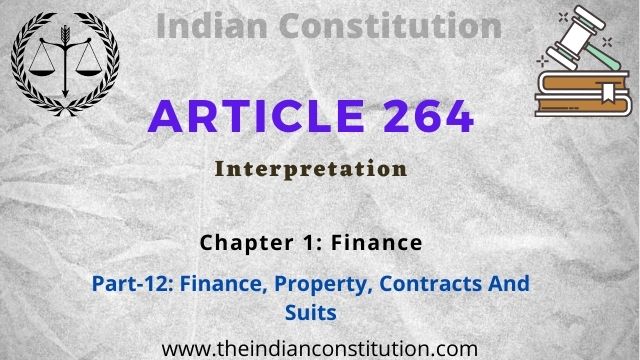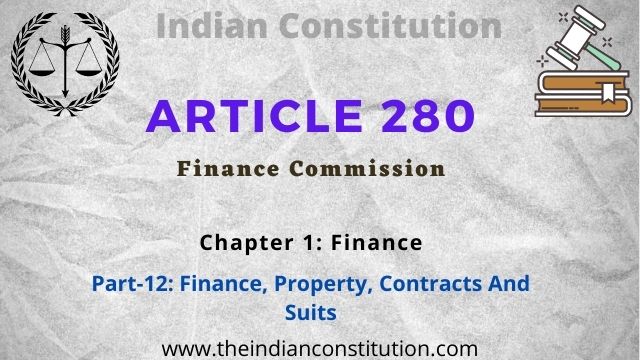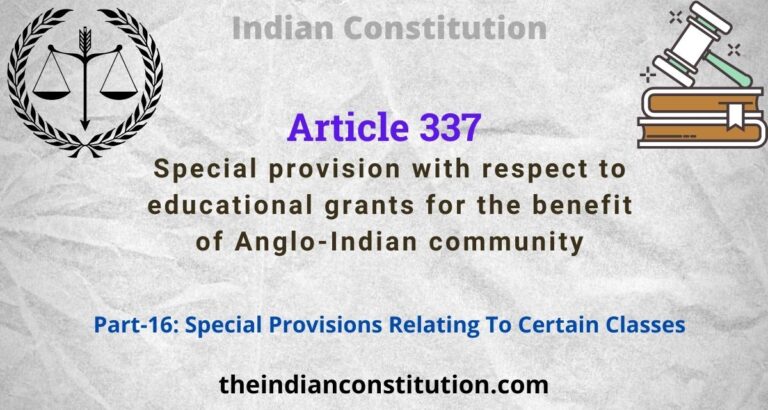Administrative Relations Between Centre And State
Articles 256 to 263 in Part XI of the Constitution deal with administrative relations between the Center and the States. Apart from this, there are many other articles related to the same matter.
Distribution of Executive Powers
The executive power has been divided between the Centre and the states on the lines of the distribution of legislative powers, except in a few cases.
Thus, the executive power of the Center extends to the whole of India: (i) on matters on which Parliament has exclusive power to make laws (i.e., subjects included in the Union List); and (ii) for the exercise of the rights, authority and jurisdiction conferred by any treaty or agreement. Similarly, the executive power of a State extends to its territory with respect to matters over which the State legislature has exclusive power to make laws (i.e., subjects included in the State List).
In respect of matters on which both Parliament and the State Legislature have the power to make laws (that is, subjects included in the Concurrent List), the executive power rests with the States, except when a constitutional provision or parliamentary law specifically provides for it. Provides. Center.
Therefore, a law on a concurrent subject, though enacted by Parliament, is to be executed by the States, except when the Constitution or Parliament directs otherwise.
Obligation of States and the Centre
In order to give ample scope to the Center to exercise its executive power in an unrestricted manner, the Constitution has imposed two restrictions on the executive power of the States.
Thus, the executive power of every State must be exercised in such a manner (a) as to ensure compliance with laws made by Parliament and any existing law for the time being in force in the State; and (b) not interfere with or prejudice the exercise of the executive power of the Union in the State.
While the first imposes a general obligation on the State, the second imposes a specific obligation on the State not to obstruct the executive power of the Centre.
In both cases, the executive power of the Center extends to giving such directions to the State as are necessary for the purpose. The approval behind these instructions of the Center is of an aggressive nature.
Thus, Article 365 says that where a State has failed to comply with (or give effect to) any direction given by the Centre, it shall be lawful for the President to deem that a situation has arisen in which the Government of the State Can’t do this. It should be carried forward as per the provisions of the Constitution.
That means, in such a situation, the President’s rule can be imposed in the state under Article 356.
Centre’s Directions to the States
Apart from the above two matters, the Center has the power to give directions to the States with respect to the exercise of their executive power in the following matters:
(i) the construction and maintenance by the State of means of communication (declared to be of national or 077 military importance);
(ii) measures to be taken for the safety of railways within the State;
(iii) Provision of adequate facilities for instruction in the mother tongue at the primary stage of education to the children of linguistic minority groups in the State; And
(iv) Formulation and implementation of specified schemes for the welfare of the Scheduled Tribes in the State.
The coercive sanction behind central directions under Article 365 (mentioned above) also applies in these cases.
Mutual Delegation of Functions
The distribution of legislative powers between the Center and the states is rigid. As a result, the Center cannot delegate its legislative powers to the states and no state can request the Parliament to make laws on any state subject. Normally the distribution of executive power is followed by the distribution of legislative powers. But, such a rigid division in the executive sphere may sometimes lead to conflict between the two. Therefore, the Constitution provides for inter-governmental delegation of executive functions to reduce rigidity and avoid situations of deadlock.
Accordingly, the President may, with the consent of the State Government, delegate to that Government any executive function of the Centre. Conversely, the Governor of a State may, with the consent of the Central Government, delegate to that Government any executive function of the State.” This mutual delegation of administrative functions may be conditional or unconditional.
The Constitution also provides for handing over the executive functions of the Center to a State without the consent of that State. But, in this case, the delegation is by the Parliament and not by the President. Thus, a law made by Parliament on a subject in the Union List may confer powers on, and impose duties on, a State, or authorize the Center to confer powers and impose duties on a State (regarding Despite the consent of the State). Notably, the same function cannot be performed by the state legislature.
From the above, it is clear that mutual delegation of functions between the Center and the State can take place either under an agreement or by law. While the Center can use both methods, a state can use only the first method.
Cooperation Between the Centre and States
The Constitution has the following provisions to ensure cooperation and coordination between the Center and the States:
(i) Parliament may make provision for the adjudication of any dispute or complaint in respect of the use, distribution, and control of the waters of any inter-State river and river valley.
(ii) The President may establish an Inter-State Council (under Article 263) to examine and discuss matters of common interest between the Center and the States. Such a council was established in 1990.
(iii) Full faith and credit should be given to the public acts, records, and judicial proceedings of the Center and each State throughout India.
(iv) Parliament may appoint an appropriate authority to carry out the purposes of the constitutional provisions relating to inter-state freedom of trade, commerce, and intercourse. But, no such authority has been appointed yet.
All-India Services
Like any other union, the Center and the States also have their own separate public services called Central Services and State Services respectively. Furthermore, the All India Services are IAS, IPS and IFS. Members of these services hold top positions (or key posts) under both the Center and the States and serve them on rotation basis. But, they are recruited and trained by the Centre.
These services are jointly controlled by the Center and the states. Ultimate control rests with the Central Government while immediate control rests with the State Governments.
In 1947, the Indian Civil Service (ICS) was replaced by the IAS, and the Indian Police (IP) was replaced by the IPS and recognized as All India Services by the Constitution.
In 1966, the Indian Forest Service (IFS) was created as the third all-India service. Article 312 of the Constitution empowers the Parliament to create new All India Services on the basis of a resolution of the Rajya Sabha.
Each of these three All India Services, despite its division into different states, forms a single service with equal rights and status and similar pay scales throughout the country.
Although All India Services violates the principle of federalism under the Constitution by restricting the autonomy and patronage of the States, they are supported on the grounds that
(i) They help in maintaining high standards of administration at the Center as well as in the States;
(ii) They help ensure uniformity of the administrative system throughout the country; and (iii) they facilitate contact, cooperation, coordination, and joint action on issues of common interest between the Center and the States.
While justifying the institution of All India Services in the Constituent Assembly, Dr. BR Ambedkar said:
“The dual polity inherent in the federal system is followed by a dual service in all Unions. In all Unions, there is a Federal Civil Service and a State Civil Service. The Indian Union, though a dual polity, will have a dual service in , but with one exception. It is recognized that every country has in its administrative structure certain positions which may be called strategic from the point of view of maintaining the standard of administration. There can be no doubt that the standard of Administration depends on the caliber of civil servants who are appointed to strategic posts. The Constitution provides that, without depriving the States of the right to create their own civil services, there shall be an All India Service, with recruitment at the all-India level. on the basis of common merit, with uniform pay scales, and whose members alone can be appointed to strategic posts throughout the Union.
Public Service Commissions
In the field of public service commissions, the Centre-state relations are as follows: (i) The Chairman and members of a state public service commission, though appointed by the governor of the President. estate can be removed only by
(ii) The Parliament can establish a Joint State Public Service Commission (JSPSC) for two or more states at the request of the state legislatures concerned. The chairman and members of the JSPSC are appointed by the president.
(iii) The Union Public Service Commission (UPSC) can serve the needs of a state at the request of the state governor and with the approval of the President.
(iv) The UPSC assists the states (when requested by two or more states) in framing and operating schemes of joint recruitment for any services for which candidates possessing special qualifications are required.
Integrated Judicial System
Although there is dual politics in India, there is no dual system of administration of justice. On the other hand, the Constitution established a unified judicial system with the Supreme Court at the top.
Below this are the State High Courts. This single system of courts enforces central laws as well as state laws. This is done to eliminate variations in the treatment process.
The judges of a State High Court are appointed by the President in consultation with the Chief Justice of India and the Governor of the State. They can also be transferred and removed by the President.
Parliament may establish a common High Court for two or more States. For example, Maharashtra and Goa or Punjab and Haryana have a single High Court.
Relations During Emergencies
(i) During the operation of a national emergency (under Article 352), the Center becomes entitled to give executive directions to the State on ‘any’ matter. Thus, the state governments come under the complete control of the Centre, although they are not suspended.
(ii) When President’s rule is imposed in a State (under Article 356), the President may take over the functions of the State Government and the powers vested in the Governor or any other executive authority in the State.
(iii) During the operation of financial emergency (under Article 360), the Center may direct the States to follow the principles of financial propriety and the President may give other necessary directions including reduction in the salaries of the State and persons serving in the State . High Court Judge.
Other Provisions
The Constitution contains the following other provisions which enable the Center to exercise control over the state administration:
(i) Article 355 imposes two duties on the Centre: (a) to protect every State from external aggression and internal disturbance; and (b) to ensure that the Government of each State is carried on in accordance with the provisions of the Constitution.
(ii) The Governor of a state is appointed by the President. He holds office at the pleasure of the President. The Governor acts in addition to the constitutional head of the state
An agent of the Center in the state. He submits periodic reports to the Center regarding the administrative matters of the state.
(iii) The State Election Commissioner, though appointed by the Governor of the State, can be removed only by the President.
Extra-Constitutional Devices
Apart from the above-mentioned constitutional instruments, there are also extra-constitutional instruments to promote cooperation and coordination between the Center and the States. These include several advisory bodies and conferences organized at the central level.
Non-constitutional advisory bodies include the Planning Commission (now NITI Aayog), National Development Council, National Integration Council, Central Health Council, Central Local Government and Urban Development Council, and Regional Councils. Eastern Council, Central Indian Medical Council, Central Council of Homeopathy, Central Family Welfare Council, Transport Development Council, University Grants Commission, etc.
Important conferences organized annually or otherwise to facilitate Centre-State consultation on various matters are as follows:
(i) The governor’s conference (presided over by the President).
(ii) The chief ministers’ conference (presided over by the prime minister).
(iii) The chief secretaries’ conference (presided over by the cabinet secretary).
(iv) The conference of inspector-general of police.
(v) The chief justices’ conference (presided over by the chief justice of India).
(vi) The conference of vice-chancellors.
(vii) The home ministers’ conference (presided over by the Central home minister).
(viii) The law ministers’ conference (presided over by the Central law minister).


